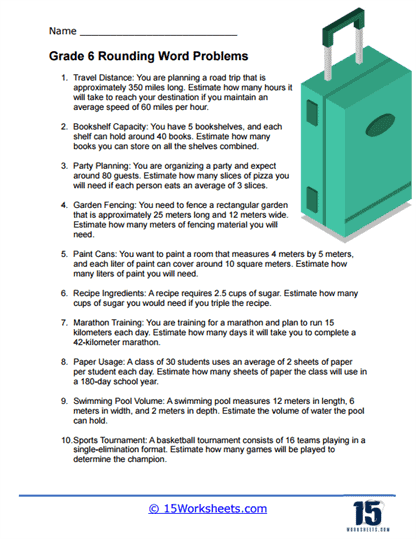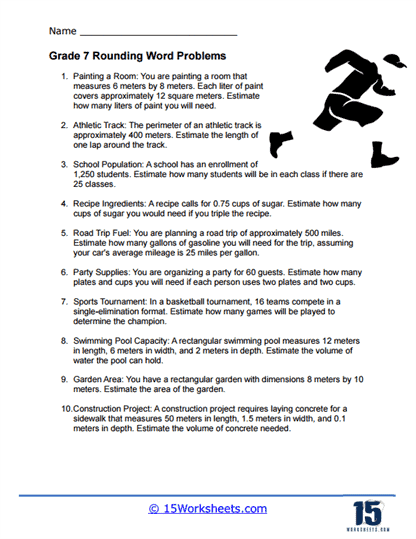Rounding Word Problems Worksheets
About These 15 Worksheets
These worksheets will help students practice and develop their skills in rounding numbers in real-world scenarios. Rounding is an essential mathematical concept that involves approximating a number to a specified place value, typically to make calculations or estimations more manageable and practical. These worksheets provide practical contexts where students can apply their knowledge of rounding to solve mathematical problems and make informed decisions.
Rounding word problem worksheets cover a wide range of topics and complexity levels, making them suitable for different grade levels and skill levels. They can involve tasks such as rounding numbers to the nearest ten, hundred, or decimal place, as well as solving real-life situations that require rounding to simplify calculations or make estimations. These problems encourage students to interpret written information, identify the appropriate rounding rules, and apply rounding techniques to find solutions.
By working through rounding word problem worksheets, students not only strengthen their rounding skills but also develop critical thinking and problem-solving abilities. They learn to use rounding as a tool to make calculations more manageable and to make quick estimations when precise values are not necessary.
What Are Rounding Word Problems?
Rounding word problems involve applying rounding techniques to real-life scenarios or practical situations. These problems often require you to round numbers to a specified degree of precision or use rounded values to estimate or approximate solutions. Rounding word problems can be encountered in various fields, such as mathematics, finance, measurements, and everyday life. Here are a few examples of rounding word problems:
Shopping – Sarah goes to a store and finds a dress that costs $47.99. She wants to estimate the total cost of purchasing three of these dresses, including tax. If the tax rate is 7.5%, round the tax to the nearest cent and calculate the estimated total cost.
Construction – John is renovating his living room and wants to install new flooring. The room measures 12.3 feet by 9.6 feet. If he needs to purchase flooring by the square foot, how many square feet of flooring should he buy? Round your answer to the nearest whole number.
Recipe – A cake recipe calls for 1.75 cups of flour. If Sarah wants to double the recipe to make a larger cake, how many cups of flour should she use? Round your answer to the nearest tenth of a cup.
Time estimation – A car is traveling at an average speed of 56.8 miles per hour. If the destination is 165 miles away, estimate how long it will take to reach the destination in hours, rounding to the nearest whole number.
Temperature – The weather forecast predicts a high temperature of 84.6 degrees Fahrenheit for tomorrow. If the temperature is rounded to the nearest degree, what will be the forecasted high temperature?
Examples of Rounding Word Problems
Problem 1 (Easy): Sarah bought 5 shirts, each costing $13.25. What is the estimated total cost of the shirts?
Solution: To estimate the total cost, you can round the price of each shirt to the nearest dollar and then multiply by the number of shirts:
Estimated cost per shirt = $13.25 rounded to the nearest dollar = $13
Total estimated cost = Estimated cost per shirt * Number of shirts
Total estimated cost = $13 x 5
Total estimated cost = $65
So, the estimated total cost of the 5 shirts is $65.
Problem 2 (Intermediate): A store sells electronic gadgets, and the cost of a laptop is $789. If the store wants to display the price with only the hundreds digit visible, what will be the displayed price?
Solution: To display only the hundreds digit, you’ll need to round the price to the nearest hundred:
Rounded price = $789 rounded to the nearest hundred
Rounded price = $800
So, the displayed price of the laptop will be $800.
In this case, we round up because the tens and ones digits are greater than or equal to 5.
In What Situations Are We Required to Round Numbers?
Rounding numbers is often necessary in various situations to simplify calculations, provide estimates, or present data in a more manageable format. Here are some common situations where rounding numbers is typically required:
Mathematical calculations – When performing mathematical operations involving numbers with many decimal places, rounding is often necessary to obtain practical or meaningful results. For example, when adding or subtracting numbers with different decimal places, rounding the result to a certain number of decimal places can provide a more precise answer.
Financial transactions – In financial contexts, rounding is often used to simplify monetary values. Currencies typically have fixed decimal places (e.g., dollars and cents), and rounding is necessary to ensure accurate calculations and represent amounts in the appropriate currency units.
Measurements and units – When working with measurements, rounding is often used to reduce the level of precision to a reasonable level. For instance, if a measurement scale allows for readings up to two decimal places, rounding to the nearest hundredth may be necessary to express the value adequately.
Statistical analysis – In statistical analysis, rounding numbers can help to make data more manageable and easier to interpret. For instance, when reporting percentages or proportions, rounding is typically used to a specific number of decimal places to convey meaningful information without overwhelming readers with excessive precision.
Data presentation and reporting – Rounding numbers is often essential when presenting data in graphs, charts, or tables. To maintain clarity and avoid clutter, rounded values are commonly used in these visual representations.
Estimations and approximations – Rounding is frequently employed to provide quick estimates or approximations in everyday situations. For example, when calculating tips, estimating costs, or making rough calculations mentally, rounding simplifies the process and yields practical results.
What Types of Jobs and Careers Use Rounding Regularly?
Rounding is a common practice in various jobs and careers that involve mathematical calculations, data analysis, financial transactions, measurements, and estimations. Here are some fields where rounding is frequently used:
Finance and Accounting – Professionals in finance and accounting roles often work with numbers that require rounding. This includes financial statements, budgeting, tax calculations, investment analysis, and currency conversions.
Statistics and Data Analysis – Rounding is essential in statistical analysis when presenting data, calculating proportions, margins of error, and rounding survey results. Statisticians and data analysts need to understand rounding rules to accurately interpret and communicate data.
Engineering and Architecture – Engineers and architects regularly encounter rounding in their work, particularly when dealing with measurements, dimensions, and calculations involving tolerances. Rounding is crucial for designing structures, creating blueprints, and ensuring accuracy within acceptable limits.
Retail and Pricing – Pricing specialists and retailers often round prices to customer-friendly values or specific decimal places. They round product prices, discounts, sales tax calculations, and financial transactions to simplify the pricing process and enhance customer experience.
Research and Scientific Analysis – Scientists, researchers, and analysts use rounding in various scientific fields. Rounding is applied to experimental measurements, laboratory data, statistical analysis, and research findings to present results and simplify complex numerical values.
Education and Teaching – Teachers at various levels, from elementary to higher education, often encounter rounding in mathematics instruction. They teach rounding techniques to students, use rounding in grading and assessment, and incorporate rounding word problems to develop mathematical skills.
Actuarial Science and Insurance – Actuaries working in insurance companies use rounding in calculating premiums, policy values, claims, and risk assessments. Rounding is essential for ensuring accurate calculations and maintaining consistency in insurance-related computations.
Retail Banking and Personal Finance – Bankers, financial advisors, and loan officers often work with rounded values when dealing with customer accounts, interest rates, loan calculations, investment returns, and financial planning.
Supply Chain and Logistics – Professionals involved in supply chain management and logistics may use rounding for inventory management, order quantities, transportation calculations, and capacity planning.
Gaming and Probability – Rounding is important in gambling and gaming industries where odds, probabilities, and payout calculations need to be rounded to provide clear and practical information to players and ensure fairness.















